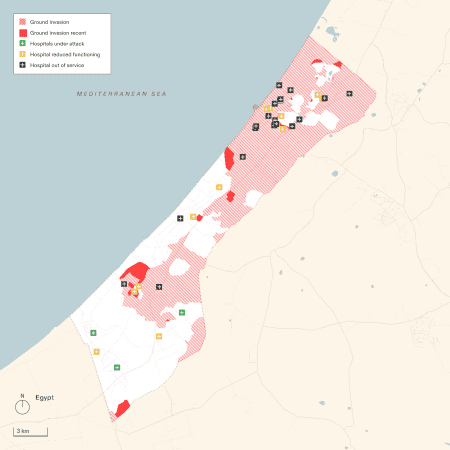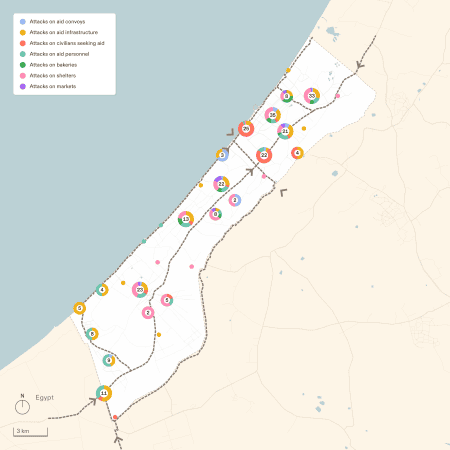Destruction of Agriculture and Water Resources: Summary of Findings
The Israeli military destroyed agriculture and water resources across Gaza, in a manner which was cumulative, repetitive, and with long-term effects.

Quantitative findings
Between 7 October 2023 and 30 June 2024:
- Approximately 83% of all plant life in Gaza was destroyed.
- Approximately 70% of Gaza’s agricultural land, 104 sq km (out of 150 sq km) of fields and orchards, were destroyed.
- More than 3,700 greenhouse structures in Gaza, 45% of its total, were destroyed.
- More than 47% of groundwater wells and 65% of water tanks were destroyed or damaged. The status of 29% of the wells is unknown.
- None of the wastewater treatment facilities in Gaza have remained intact or functional.
Pattern findings
- The Israeli military repeatedly destroyed agriculture and water resources across Gaza.
- Month-by-month analysis in this period shows a correlation between the destruction of agricultural lands and infrastructure, and the Israeli military’s ground position.
- The destruction of agricultural lands and infrastructure was cumulative and repeated.
- The Israeli military’s conduct has likely caused contamination in Gaza’s land and water resources.
Destruction of Medical Infrastructure: Summary of Findings
Israel repeatedly targeted hospitals and other medical infrastructure, suggesting an intention to destroy Gaza’s medical system.

Quantitative Findings
Between 7 October 2023 and 1 August 2024:
- Hospitals out of service: 35 of 36 at least once.
- Directly targeted: 31 of 36 hospitals.
- Under siege: 11 hospitals, with 5 under siege twice.
- Invaded: 10 hospitals, with 4 invaded twice.
- Field hospitals: 4 evacuated and forced out of service.
- 1 hospital (Patient’s Friends Society Hospital) has been attacked and forced out of service twice, having rebuilt and reestablished operations.
- 27 hospitals are within areas that received evacuation orders.
Pattern Findings
- The Israeli military’s targeting of hospitals follows a consistent and discernible pattern of five typically consecutive phases:
- Evacuation orders (27 hospitals),
- Surrounding areas attacked (29 hospitals),
- Direct attacks (31 hospitals),
- Siege (11 hospitals),
- Invasion (10 hospitals).
- The Israeli military’s attack on hospitals correlates with the advancement and presence of Israeli ground forces.
- The first hospitals in Gaza forced out of service by Israeli attacks were in areas into which the ground invasion first advanced;
- The position of the Israeli ground forces correlates with where hospitals were subsequently forced out of service;
- When large hospitals were attacked by Israeli ground forces, small hospitals in the surrounding area were often also attacked and forced out of service.
- Sites of medical infrastructure where healthcare services were either reestablished or newly introduced were subsequently targeted by the Israeli military.
- The timing of the Israeli military’s attacks on hospitals correlates with the presence of displaced civilians at those hospitals.
- The Israeli military targeted medical personnel and facilities in a manner which caused damage to Gaza’s medical system.
- Healthcare workers have been direct targets of the Israeli military, as opposed to being indirect casualties of attacks on hospitals;
- The Israeli military destroyed and occupied hospitals even after they had been forced out of service and evacuated;
- The Israeli military’s targeting of hospitals caused damage to Gaza’s maternity services.
Destruction of Civilian Infrastructure: Summary of Findings
Israel’s attacks on civilian infrastructure suggests an effort to destroy the ability to sustain civilian life and disrupt civilian access to critical infrastructure.

Quantitative Findings (7 October 2023 – 6 July 2024)
- Health facilities: 57% attacked; 45 damaged, 18 destroyed (of 110).
- Shelters: 71% attacked; 219 damaged, 31 destroyed (of 353).
- Utilities: 53% attacked; 166 damaged, 152 destroyed (of 605).
- Schools: 75% attacked; 334 damaged, 91 destroyed (of 564).
- University facilities: 81% attacked; 18 damaged, 18 destroyed (of 44).
- Government buildings: 82% attacked; 17 damaged, 20 destroyed (of 45).
- Religious institutions: 80% attacked; 143 damaged, 130 destroyed (of 341).
- Cultural sites: 91% attacked; 10 damaged, 30 destroyed (of 44).
- Roads: 47.3% damaged in North Gaza (7 Oct – 7 Nov); 33.7% in South Gaza (7 Oct – 7 Jan).
Between 5 May to 6 July 2024:
- 10,308 structures damaged; This is more than double the number of structures destroyed in the previous two months.
- 9,524 structures destroyed; This is three times higher than the number of damaged structures in the previous two months.
Pattern Findings
7-28 October 2023 (aerial bombing campaign)
- Timing: Strikes correlated with the time at which a higher density of civilians would be expected to be present; residential areas were hit more at night, commercial spaces during operating hours.
- Distribution: Israel’s attacks south of Wadi Gaza increased after it ordered civilians from the north to evacuate to the south.
7 October 2023 – 6 July 2024 (wider military campaign)
- Public infrastructure was destroyed even after it had been previously damaged, and when it was unlikely to be occupied.
- Areas in proximity to critical infrastructure were targeted:
- We observed repeated damage to service roads immediately surrounding critical infrastructure.
- We observed repeated destruction of buildings in the same vicinity, leading to accumulation of debris on the roads surrounding critical infrastructure.
- Repeated disruption of road networks isolated civilians in two ways:
- It was more difficult for civilians to leave areas in which infrastructure had been destroyed.
- It was more difficult for aid to reach civilians in those areas disconnected from the road network.
Targeting of Aid: Summary of Findings
Israel targeted sites and systems of humanitarian aid delivery and distribution when and where they became the main mode of aid facilitation.

Quantitative Findings
- Total incidents of targeting aid: 322
- Attacks by category: 17 on bakeries, 73 on shelters, 60 on aid personnel, 50 on civilians seeking aid, 78 on aid infrastructure sites such as warehouses and water treatment facilities, 22 on aid convoys, 6 on aid convoys by Israeli vigilantes en route through Israel or the West Bank, 16 on markets.
- At least 17 of the attacks on aid personnel, convoys, and infrastructure targeted sites involved in operations that had been officially coordinated with Israel and recognised as ‘deconflicted sites’.
- UNRWA targeting: 39 attacks on UNRWA personnel and assets; 195 UNRWA personnel killed (177 staff members, 18 other aid workers), 40 detained by the Israeli military.
Pattern Findings
- We observed that the Israeli military’s targeting of aid followed a pattern of overlapping phases, during which attacks on the specified aid categories intensified
- October–November 2023: Bakeries in the north of Gaza were targeted when they played a critical role in aid distribution. By mid-November there were no official bakeries still in operation in Gaza City.
- October 2023–January 2024: Shelters were targeted when they assumed a central role in housing people displaced by Israeli attacks, and facilitating the receipt and preparation of food aid.
- December 2023–February 2024: Palestinian police officers (aid personnel) were targeted when they played a critical role in escorting aid convoys.
- January–March 2024: Civilians gathering for aid near the Netzarim corridor checkpoints were repeatedly targeted.
- March 2024: Aid administrators from organisations and groups that took up responsibility for facilitating aid delivery and distribution (aid personnel) were targeted when they began to play a prominent role in its organisation. Attacks on these personnel and organisations were extensive enough to eliminate their key administrators or otherwise force them to cease operating.
- October 2023, December 2023, May 2024: Aid distribution and storage sites, including warehouses and markets, were targeted when they were actively operating to supply civilians with food, with severe attacks on Rafah crossing, Karem Abu Salem/Kerem Shalom crossing, and markets during periods of increased aid-entering.
- May 2024: Israeli vigilantes attacked aid convoys passing through Israel and the occupied West Bank under the watch and sometimes with direct support of Israeli military personnel.
- Increases in aid flow into Gaza (late December 2023; late March, April, and May 2024) coincided with an increase in Israel’s targeting of Gaza’s aid distribution systems, including logistics, personnel and necessary infrastructure.
- The targeting of aid occurred in tandem with the Israeli
military’s evacuation orders and coincides with its attempts to force
Palestinian civilians to displace from the north of Gaza.
The construction of the new internal border in the Netzarim corridor and the checkpoints within it supporting a one-way (north to south) movement of civilians coincided with the restriction of aid as a means of displacement.
The report, ‘A Spatial Analysis of the Israeli Military’s Conduct in Gaza since October 2023,’ is derived from Forensic Architecture’s ongoing research into the Israeli military’s conduct in Gaza and was provided to the legal team representing South Africa in the case of the Application of the Convention on the Prevention and Punishment of the Crime of Genocide in the Gaza Strip (South Africa v. Israel), after being approached by the legal team representing South Africa to provide independent research and reporting for their ongoing submission in this case. For the provision of this report, Forensic Architecture received payment from the South African Government.

No comments:
Post a Comment